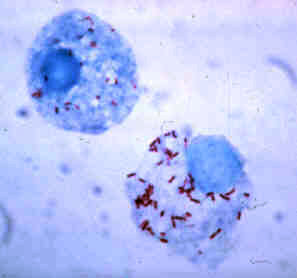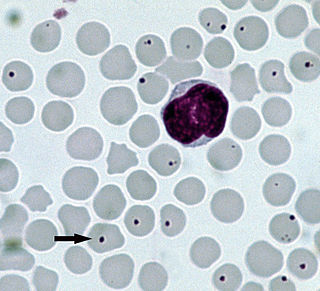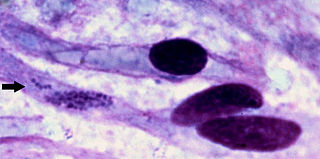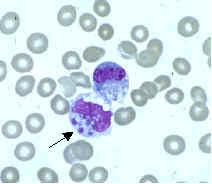Ehrlichiosis is a tick-borne disease of dogs usually caused by the rickettsial agent Ehrlichia canis. Ehrlichia canis is the pathogen of animals. Humans can become infected by E. canis and other species after tick exposure. German Shepherd Dogs are thought to be susceptible to a particularly severe form of the disease; other breeds generally have milder clinical signs. Cats can also be infected.

Rickettsia rickettsii is a Gram-negative, intracellular, coccobacillus bacterium that was first discovered in 1902. Having a reduced genome, the bacterium harvests nutrients from its host cell to carry out respiration, making it an organoheterotroph. Maintenance of its genome is carried out through vertical gene transfer where specialization of the bacterium allows it to shuttle host sugars directly into its TCA cycle.
Tick-borne diseases, which afflict humans and other animals, are caused by infectious agents transmitted by tick bites. They are caused by infection with a variety of pathogens, including rickettsia and other types of bacteria, viruses, and protozoa. The economic impact of tick-borne diseases is considered to be substantial in humans, and tick-borne diseases are estimated to affect ~80 % of cattle worldwide. Most of these pathogens require passage through vertebrate hosts as part of their life cycle. Tick-borne infections in humans, farm animals, and companion animals are primarily associated with wildlife animal reservoirs. Many tick-borne infections in humans involve a complex cycle between wildlife animal reservoirs and tick vectors. The survival and transmission of these tick-borne viruses are closely linked to their interactions with tick vectors and host cells. These viruses are classified into different families, including Asfarviridae, Reoviridae, Rhabdoviridae, Orthomyxoviridae, Bunyaviridae, and Flaviviridae.

Bartonella is a genus of Gram-negative bacteria. It is the only genus in the family Bartonellaceae. Facultative intracellular parasites, Bartonella species can infect healthy people, but are considered especially important as opportunistic pathogens. Bartonella species are transmitted by vectors such as fleas, sand flies, and mosquitoes. At least eight Bartonella species or subspecies are known to infect humans.

Dermacentor variabilis, also known as the American dog tick or wood tick, is a species of tick that is known to carry bacteria responsible for several diseases in humans, including Rocky Mountain spotted fever and tularemia. It is one of the best-known hard ticks. Diseases are spread when it sucks blood from the host. It may take several days for the host to experience symptoms.
A canine vector-borne disease (CVBD) is one of "a group of globally distributed and rapidly spreading illnesses that are caused by a range of pathogens transmitted by arthropods including ticks, fleas, mosquitoes and phlebotomine sandflies." CVBDs are important in the fields of veterinary medicine, animal welfare, and public health. Some CVBDs are of zoonotic concern.

Anaplasma phagocytophilum is a Gram-negative bacterium that is unusual in its tropism to neutrophils. It causes anaplasmosis in sheep and cattle, also known as tick-borne fever and pasture fever, and also causes the zoonotic disease human granulocytic anaplasmosis.

Anaplasmosis is a tick-borne disease affecting ruminants, dogs, and horses, and is caused by Anaplasma bacteria. Anaplasmosis is an infectious but not contagious disease. Anaplasmosis can be transmitted through mechanical and biological vector processes. Anaplasmosis can also be referred to as "yellow bag" or "yellow fever" because the infected animal can develop a jaundiced look. Other signs of infection include weight loss, diarrhea, paleness of the skin, aggressive behavior, and high fever.

Ehrlichiosis is a tick-borne bacterial infection, caused by bacteria of the family Anaplasmataceae, genera Ehrlichia and Anaplasma. These obligate intracellular bacteria infect and kill white blood cells.

Ehrlichia is a genus of Rickettsiales bacteria that are transmitted to vertebrates by ticks. These bacteria cause the disease ehrlichiosis, which is considered zoonotic, because the main reservoirs for the disease are animals.

Amblyomma americanum, also known as the lone star tick, the northeastern water tick, or the turkey tick, is a type of tick indigenous to much of the eastern United States and Mexico, that bites painlessly and commonly goes unnoticed, remaining attached to its host for as long as seven days until it is fully engorged with blood. It is a member of the phylum Arthropoda, class Arachnida. The adult lone star tick is sexually dimorphic, named for a silvery-white, star-shaped spot or "lone star" present near the center of the posterior portion of the adult female shield (scutum); adult males conversely have varied white streaks or spots around the margins of their shields.

Heartwater is a tick-borne rickettsial disease. The name is derived from the fact that fluid can collect around the heart or in the lungs of infected animals. It is caused by Ehrlichia ruminantium —an intracellular Gram-negative coccal bacterium. The disease is spread by various Amblyomma ticks, and has a large economic impact on cattle production in affected areas. There are four documented manifestations of the disease, these are acute, peracute, subacute, and a mild form known as heartwater fever. There are reports of zoonotic infections of humans by E. ruminantium, similar to other Ehrlichia species, such as those that cause human ehrlichiosis.

Southern tick-associated rash illness (STARI) is an emerging infectious disease related to Lyme disease that occurs in southeastern and south-central United States. It is spread by tick bites and it was hypothesized that the illness was caused by the bacteria Borrelia lonestari. However, there is insufficient evidence to declare this Borrelia strain as a causative agent.

Ehrlichia ewingii is a species of rickettsiales bacteria. It has recently been associated with human infection, and can be detected via PCR serological testing. The name Ehrlichia ewingii was proposed in 1992.

Human granulocytic anaplasmosis (HGA) is a tick-borne, infectious disease caused by Anaplasma phagocytophilum, an obligate intracellular bacterium that is typically transmitted to humans by ticks of the Ixodes ricinus species complex, including Ixodes scapularis and Ixodes pacificus in North America. These ticks also transmit Lyme disease and other tick-borne diseases.

Human monocytotropic ehrlichiosis is a form of ehrlichiosis associated with Ehrlichia chaffeensis. This bacterium is an obligate intracellular pathogen affecting monocytes and macrophages.
Ehrlichiosis ewingii infection is an infectious disease caused by an intracellular bacteria, Ehrlichia ewingii. The infection is transmitted to humans by the tick, Amblyomma americanum. This tick can also transmit Ehrlichia chaffeensis, the bacteria that causes human monocytic ehrlichiosis (HME).
Ehrlichia canis is an obligate intracellular bacterium that acts as the causative agent of ehrlichiosis, a disease most commonly affecting canine species. This pathogen is present throughout the United States, South America, Asia, Africa and recently in the Kimberley region of Australia. First defined in 1935, E. canis emerged in the United States in 1963 and its presence has since been found in all 48 contiguous United States. Reported primarily in dogs, E. canis has also been documented in felines and humans, where it is transferred most commonly via Rhipicephalus sanguineus, the brown dog tick.

Rickettsia parkeri is a gram-negative intracellular bacterium. The organism is found in the Western Hemisphere and is transmitted via the bite of hard ticks of the genus Amblyomma. R. parkeri causes mild spotted fever disease in humans, whose most common signs and symptoms are fever, an eschar at the site of tick attachment, rash, headache, and muscle aches. Doxycycline is the most common drug used to reduce the symptoms associated with disease.
Heartland bandavirus, sometimes called Heartland virus (HRTV), is a tick-borne phlebovirus of the Bhanja virus serocomplex discovered in 2009. The lone star tick transmits the virus to people when feeding on blood. As of 2017, only five states in the Central United States have reported 20 human infections, namely Arkansas, Indiana, Missouri, Oklahoma, and Tennessee; symptoms resemble those of two other tick-borne infections ehrlichiosis and anaplasmosis. The reservoir host is unknown, but deer, raccoon, coyotes, and moose in 13 different states have antibody titers against the virus. By 2023 over 50 human infections were reported in at least eleven states.










